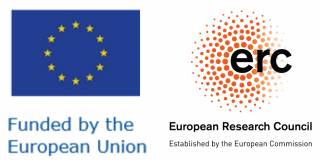
We seek ideas for imaginative projects.
FAIRY
 Recently, light-responsive soft materials have proven their unique ability of actuation, providing novel approaches for miniaturization of soft robots by powering them wirelessly through remotely controlled light beam(s). This has led to demonstrations of versatile light-driven robots that can walk, swim, jump, etc. FAIRY will take a significant leap in material science to develop small-scale light driven flying robots with adaptive features inspired by biological organisms.
Recently, light-responsive soft materials have proven their unique ability of actuation, providing novel approaches for miniaturization of soft robots by powering them wirelessly through remotely controlled light beam(s). This has led to demonstrations of versatile light-driven robots that can walk, swim, jump, etc. FAIRY will take a significant leap in material science to develop small-scale light driven flying robots with adaptive features inspired by biological organisms.
OPTOPUS
 Soft robotics offers technical innovations to overcome the grand challenges encountered in conventional rigid machines that relate to adaptive motion and safety concerns. However, presently available actuation and control strategies prevent device miniaturization. OPTOPUS aims at developing a new type of wireless soft robotic system with overall size in a millimetre range, that is capable of sophisticated functions when fuelled by light energy only. Drawing from physics, microrobotics, chemistry and material science, we devise soft-bodied robots that perform jumping and 2D locomotion steering with light, as well as miniature actuators that can recognize and grasp objects based on their colours
Soft robotics offers technical innovations to overcome the grand challenges encountered in conventional rigid machines that relate to adaptive motion and safety concerns. However, presently available actuation and control strategies prevent device miniaturization. OPTOPUS aims at developing a new type of wireless soft robotic system with overall size in a millimetre range, that is capable of sophisticated functions when fuelled by light energy only. Drawing from physics, microrobotics, chemistry and material science, we devise soft-bodied robots that perform jumping and 2D locomotion steering with light, as well as miniature actuators that can recognize and grasp objects based on their colours
ONLINE
 Self-oscillation is a phenomenon where an object sustains periodic motion upon non-periodic stimulus. It occurs commonly in nature, a few examples being heartbeat, ocean waves and the fluttering of leaves, in which the feedback mechanics always plays an essential role. Stimuli-responsive materials allow creating self-oscillators that can transfer different forms of energy, e.g., heat, light and chemicals into cyclic mechanical motion, and interactions between different materials. ONLINE provides a general design route for responsive materials to obtain their communication through physical contact, hydrodynamic interaction and light beams. Bioinspiration is our general guideline, and we wish to create new concepts of optical feedback mechanisms for robotic interaction, which can be generalized to other materials or chemical systems.
Self-oscillation is a phenomenon where an object sustains periodic motion upon non-periodic stimulus. It occurs commonly in nature, a few examples being heartbeat, ocean waves and the fluttering of leaves, in which the feedback mechanics always plays an essential role. Stimuli-responsive materials allow creating self-oscillators that can transfer different forms of energy, e.g., heat, light and chemicals into cyclic mechanical motion, and interactions between different materials. ONLINE provides a general design route for responsive materials to obtain their communication through physical contact, hydrodynamic interaction and light beams. Bioinspiration is our general guideline, and we wish to create new concepts of optical feedback mechanisms for robotic interaction, which can be generalized to other materials or chemical systems.
Funding source: ERC Starting Grant 2022.
